目次
2月号【法務】ニュースレター
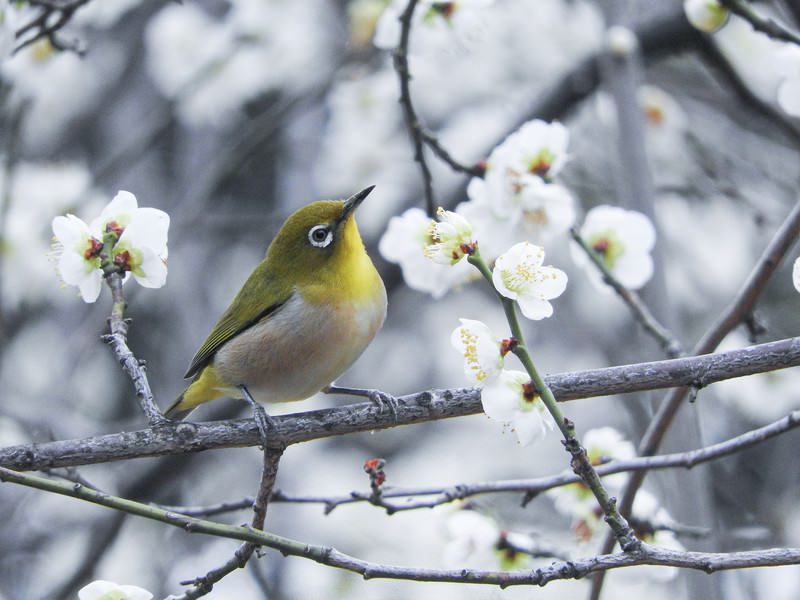
中国意匠:専利法実施細則・審査指南の改正
2024年1月20日に施行
中国において、2021年6⽉1⽇に専利法第4回改正が施⾏されて以降、専利法実施細則及び専利審査指南の改正作業に時間がかかっていたが、ついに2024年1月20日に改正法が施行されることになった。
当ニュースレターでは、改正法のうち、主に日本から中国へ意匠出願する場合に影響が大きい、「部分意匠」について紹介したい。
部分意匠の物品名
物品全体および保護しようとする部分の、双方の名称を記載する。
(例)「自動車のドア」、「携帯電話のカメラ」
部分意匠の図面
・物品全体の図面が必要。
・保護しようとする部分を、破線と実線の組み合わせ、着色の有無等の方法で示す。
・一点鎖線は、破線と実線の境界を示すために使用できる。
部分意匠の簡単な説明
・破線と実線の組み合わせで示す場合を除き、保護しようとする部分を記載する。
・必要に応じて、保護しようとする部分の用途を記載する。
・設計要点を表明する指定図は、保護しようとする部分を含める。
部分意匠の登録要件
・製品において相対的に独立した領域、または、相対的に完全な設計単位を構成しない部分は、 部分意匠として登録できない。(審査指南:第1部分第3章7.4 節)
・物品の表面上の模様、または、模様と色彩の組合せのみの意匠の場合は、部分意匠として登録できない。(審査指南:第1部分第3章7.4 節)
部分意匠の一意匠
同一物品において接続関係がない2つ以上の部分意匠は、機能または設計上関連し、かつ特定の視覚効果がある場合、一件の意匠として出願できる。(審査指南:第1部分第3章9 節)
組物の意匠
部分意匠は、組物の意匠出願に含めることはできない。(審査指南:第1部分第3章9.2 節)
部分意匠の分割出願
親出願が部分意匠である場合、物品の全体またはその他の部分について、分割出願することはできない。(審査指南:第1部分第3章9.4.2 節)
部分意匠の類否判断
部分意匠につき、物品のカテゴリーの同一又は類似を判断する際に、物品全体および保護しようとする部分の両方の用途を考慮する必要がある。(審査指南:第4部分第5章5.1 節)
文化庁、「AIと著作権に関する
考え方について(素案)」を公表
2023年12月20日に開かれた文化審議会著作権分科会法制度小委員会(第5回)において、文化庁は「AIと著作権に関する考え方について(素案)」を公表した。
当レターでは、著作権法第30条の4の解釈とその適用範囲について、文化庁の現時点での考え方を一部紹介する。
著作権法第30条の4
(著作物に表現された思想又は感情の享受を目的としない利用)
第三十条の四
著作物は、次に掲げる場合その他の当該著作物に表現された思想又は感情を自ら享受し又は他人に享受させることを目的としない場合には、その必要と認められる限度において、いずれの方法によるかを問わず、利用することができる。ただし、当該著作物の種類及び用途並びに当該利用の態様に照らし著作権者の利益を不当に害することとなる場合は、この限りでない。
一 著作物の録音、録画その他の利用に係る技術の開発又は実用化のための試験の用に供する場合
二 情報解析(多数の著作物その他の大量の情報から、当該情報を構成する言語、音、影像その他の要素に係る情報を抽出し、比較、分類その他の解析を行うことをいう。第四十七条の五第一項第二号において同じ。)の用に供する場合
三 前二号に掲げる場合のほか、著作物の表現についての人の知覚による認識を伴うことなく当該著作物を電子計算機による情報処理の過程における利用その他の利用(プログラムの著作物にあつては、当該著作物の電子計算機における実行を除く。)に供する場合
条文上、「思想又は感情を自ら享受し又は他人に享受させることを目的としない場合」(以下、非享受目的という)は、著作権者の許諾なく利用することできると規定されている(著作権法第30条の4 柱書)。そして、同条第2項において、「情報解析(…)の用に供する場合」を挙げている。そのため、現在の著作権法では、生成AIがコンテンツを学習するために行われるものも含め、情報解析の用に供する場合は、すべて非享受目的に該当し、著作権者の許諾なく利用することができると理解されてきた。
しかしながら、一個の利用行為には複数の目的が併存する場合もあり得るところ、ある利用行為が、「情報解析(…)の用に供する場合」等の非享受目的で行われる場合であっても、この非享受目的と併存して、ひとつでも享受の目的があると評価される場合は、同条の要件を欠くこととなり、法第30条の4の権利制限規定の適用を受けることができない。
生成AIに関していえば、享受目的が併存すると評価される場合について、具体的には以下のような場合が想定される。
〇学習データをそのまま出力させることを目的としたファインチューニングを行うための著作物の複製等
〇学習データの影響を強く受けた生成物が出力されるようなファインチューニングを行うための著作物の複製等
〇AI学習のために用いた学習データを出力させる意図は有していないが、既存のデータベースやWeb上に掲載されたデータの全部又は一部を、生成AIを用いて出力させることを目的として著作物の内容をベクトルに変換したデータベースを作成する等の著作物の複製等
※法第30条の4は、生成AI以外のAI(認識、識別、人の判断支援等を行うAI)を開発する学習のための著作物の利用、技術開発・実用化試験のための著作物の利用、プログラムのリバース・エンジニアリング等の行為も対象となる。
まとめ
著作権法第30条の4は、技術革新に伴う著作物の新たな利用態様に柔軟に対応できる権利制限規定として設けられた。立法時において、AIの学習についてはインターネットの検索サービスなどを念頭に置いていたと考えられる。しかしながら、近時の生成AIの技術の進展は凄まじく、事業者にとどまらず一般市民にも広く普及しつつあり、同条の解釈と適用範囲について、問題となる場面が増加している。そのため、生成AIを想定したルールの策定、適用範囲の再整理が求められている。
今般、文化庁が公表した素案によれば、生成AIに著作物を学習させる場合でも、著作物の一部を出力させる目的がある場合などには、権利者の許諾が必要となるという方向性が示された。
文化庁のスケジュールによると、2024年1月中にパブリックコメントを実施、同年3月には、文化審議会著作権分科会において報告がなされる予定である。当所ニュースレターでも、続報をお届けする予定である。
参考URL:https://www.bunka.go.jp/seisaku/bunkashingikai/chosakuken/hoseido/r05_05/
[参照] https://www.bunka.go.jp/seisaku/bunkashingikai/chosakuken/hoseido/r05_05/pdf/93980701_01.pdf
改正商標法、2024年4月1日に施行
コンセント制度の導入、他人の氏名を含む
商標の登録要件の緩和
「不正競争防止法等の一部を改正する法律」により、商標法等(特許法、実用新案法、意匠法、商標法、工業所有権に関する手続等の特例に関する法律等)の一部が改正される。
本改正により、(i)「コンセント制度の導入」、(ii)「他人の氏名を含む商標の登録要件の緩和」が予定されているところ、改正商標法の規定は、2024年4月1日から施行される。
*(ii)については、施行日(2024年4月1日)以後にした出願について適用される。
改正の概要
(i) コンセント制度
本改正により、商標法第4条に第4項が新設され、同条第1項第11号に該当する商標であっても、先行登録商標権者の承諾を得ており、かつ、先行登録商標と出願商標との間で混同を生ずるおそれがないものについては、登録が認められる。
なお、コンセント制度の適用により併存登録された商標について、登録後の混同防止を担保するため、以下の規定が新設、あるいは一部改正される。
・一方の権利者の使用により他の権利者の業務上の利益が害されるおそれのあるときは、当該使用について両商標間における混同を防ぐのに適当な表示を付すべきことを請求(混同防止表示請求)することができる(商標法第24条の4第1号及び第2号)。
・一方の権利者が不正競争の目的で他の権利者の業務に係る商品又は役務と混同を生ずる使用をしたときは、何人もその商標登録を取り消すことについて、審判(不正使用取消審判)を請求することができる(同法第52条の2第1項)。
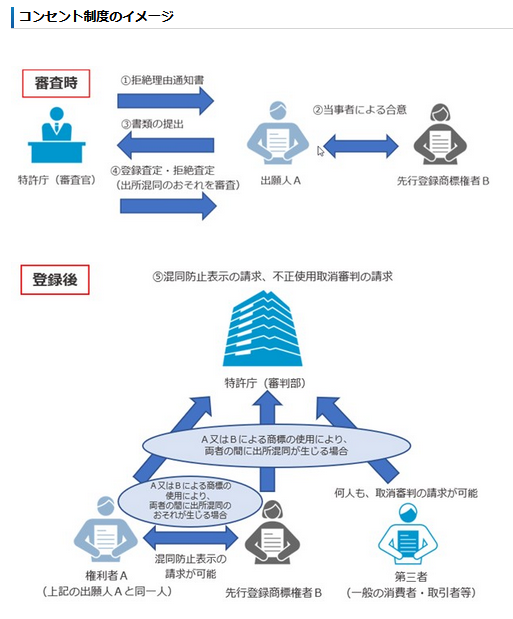
出典:特許庁<https://www.jpo.go.jp/system/trademark/gaiyo/consent/index.html>
(ii) 他人の氏名を含む商標の登録要件の緩和
改正前の商標法では、商標登録出願に係る商標の構成中に他人の氏名を含むものは、当該他人の承諾がない限り、商標登録を受けることができないとされていた。改正後の商標法では「他人の氏名」の部分に「商標の使用をする商品又は役務の分野において需要者の間に広く認識されている氏名に限る。」という知名度要件が追加された(商標法第4条第1項第8号)。これにより、知名度要件を満たさない他人の氏名を含む商標の場合は、当該他人の承諾は不要で、政令要件(㋐「相当の関連性」㋑「不正の目的でないこと」)を満たせば、商標登録が可能になる。
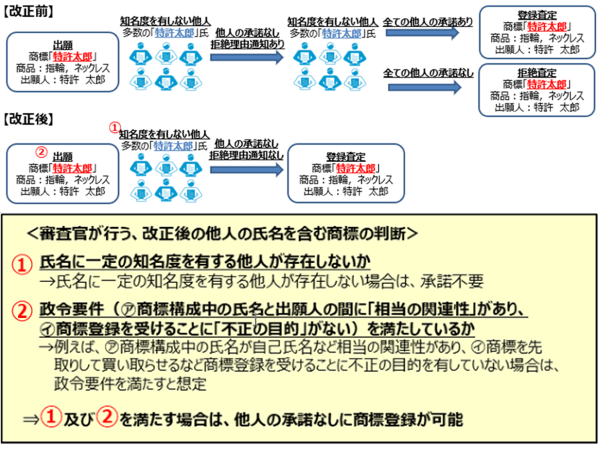
出典:特許庁<https://www.jpo.go.jp/system/trademark/gaiyo/seidogaiyo/shimei.html>
Newsletter translated into English


China Designs: Revision of Implementing Regulations of the Patent Law and Examination Guidelines – Entered into force on January 20, 2024
Since the 4th Amendment of the Patent Law was implemented on June 1, 2021, it has taken a long time to amend the Implementing Regulations of the Patent Law and the Guidelines for Patent Examination in China, which finally came into effect on January 20, 2024.
In this newsletter, we would like to mainly introduce from revised law “partial designs”, which will have a significant impact on design applications from Japan to China.
Name of the article of a partial design
The name of the article as a whole and the name of the part to be protected must be stated.
(Examples: “door of a car”, “camera of a cellular phone”)
Drawings of the partial design
・A drawing of the entire article is required.
・The part to be protected shall be indicated by a combination of dashed and solid lines, with or without coloring, etc.
・A dashed dotted line may be used to indicate the boundary between dashed and solid lines.
Brief explanation of partial design
・The part to be protected should be described, except in cases where a combination of dashed and solid lines is used.
・The use of the part to be protected should be indicated, if necessary.
・Designation drawings expressing the essentials of the design shall include the part sought to be protected.
Requirements for registration of a partial design
・Any part of a product that does not constitute a relatively independent area or a relatively complete design unit may not be registered as a partial design. (Examination Guidelines: Part 1, Chapter 3, Section 7.4)
・A design which consists only of a pattern on the surface of an article or a combination of pattern and color is not registrable as a partial design. (Examination Guidelines: Part 1, Chapter 3, Section 7.4)
Single design or a partial design
Two or more unconnected partial designs of the same article may be filed as a single design if they are related in function or design and have a specific visual effect. ((Examination Guidelines: Part 1, Chapter 3, Section 9)
Design of an assembly
A partial design may not be included in an application for a design of an assembly. (Examination Guidelines: Part 1, Chapter 3, Section 9.2)
Divisional application of a partial design
If the parent application is a partial design, a divisional application may not be filed for the whole or any other part of the article. (Examination Guidelines: Part 1, Chapter 3, Section 9.4.2)
Judgment as to whether a partial design is similar or not
When determining the identity or similarity of the category of articles for a partial design, it is necessary to consider the use of both the whole article and the part to be protected. (Examination Guidelines: Part 4, Chapter 5, Section 5.1)
Agency for Cultural Affairs releases “Draft Approach to AI and Copyright”
At the 5th meeting of the Subcommittee on Legal System of the Copyright Subcommittee of the Council for Cultural Affairs held on December 20, 2023, the Agency for Cultural Affairs published a “Draft Approach to AI and Copyright”.
This article introduces some of the Agency’s current thinking on the interpretation of Article 30-4 of the Copyright Act and its scope of application.
Article 30-4 of the Copyright Act
(Exploitation without the Purpose of Enjoying the Thoughts or Sentiments Expressed in a Work)
Article 30-4
It is permissible to exploit a work, in any way and to the extent considered necessary, in any of the following cases, or in any other case in which it is not a person’s purpose to personally enjoy or cause another person to enjoy the thoughts or sentiments expressed in that work; provided, however, that this does not apply if the action would unreasonably prejudice the interests of the copyright owner in light of the nature or purpose of the work or the circumstances of its exploitation:
(i) if it is done for use in testing to develop or put into practical use technology that is connected with the recording of sounds or visuals of a work or other such exploitation;
(ii) if it is done for use in data analysis (meaning the extraction, comparison, classification, or other statistical analysis of the constituent language, sounds, images, or other elemental data from a large number of works or a large volume of other such data; the same applies in Article 47-5, paragraph (1), item (ii));
(iii) if it is exploited in the course of computer data processing or otherwise exploited in a way that does not involve what is expressed in the work being perceived by the human senses (for works of computer programming, such exploitation excludes the execution of the work on a computer), beyond as set forth in the preceding two items
Article 30-4 of the Copyright Act stipulates that “when the purpose is not to personally enjoy or cause another person to enjoy thoughts or sentiments” (hereinafter referred to as “non-enjoyment purpose”), the use may be made without the permission of the copyright holder (Article 30-4, Pillar 1 of the Copyright Act). Paragraph 2 of the same Article states “use in data analysis”. Therefore, under the current Copyright Law, it has been understood that any use of material for data analysis, including the training of generative AI, falls under the category of a non-enjoyment purpose and thus can be carried out without the permission of the copyright holder.
However, there can be cases where multiple purposes coexist in a single act of use. In such a case, even if one or more purposes of a certain act of use falls under the category of “use in data analysis” or another non-enjoyment purpose, if any of the purposes is deemed to be an enjoyment purpose, the requirements of Article 30-4 of the Act are not met and the rights limitation provision of Article 30-4 of the Act may not be applied.
In the case of generative AI, the following cases can be assumed as specific examples of cases in which the an enjoyment purpose is regarded as coexisting with a non-enjoyment purpose .
(1) Reproduction, etc. of a work for the purpose of fine tuning with the aim of outputting the learning data as it is
(2) Reproduction of works for the purpose of fine tuning to output products strongly influenced by learning data
(3) Reproduction, etc. of a work for the purpose of creating a database in which the contents of a work are converted into vectors for the purpose of outputting all or part of an existing database or data posted on the Web using a generative AI, even though there is no intention to output training data used for AI learning.
Article 30-4 of the Copyright Act also covers the use of works for learning in order to develop AI other than generative AI (AI that performs recognition, identification, human judgment support, etc.), use of works for technological development and practical use testing, reverse engineering of programs, and other acts.
Summary
Article 30-4 of the Copyright Act was established as a right limitation provision to flexibly respond to new modes of use of copyrighted works in line with technological innovation. At the time of the legislation, it was believed that AI learning was intended for Internet search services and the like. However, the recent technological progress of generative AI has been tremendous, and it is becoming widely used not only by businesses but also by the general public, which has led to an increasing number of problematic situations regarding the interpretation and scope of application of the Article. Therefore, there is a need to formulate rules and reorganize the scope of application in anticipation of generated AI.
According to a draft proposal recently released by the Agency for Cultural Affairs, the direction is that even in the case of having a generative AI learn a copyrighted work, permission of the right holder is required when, for example, the purpose is to output a part of the copyrighted work.
According to the Agency’s schedule, public comments will be made during January 2024, and a report will be made at the Copyright Subcommittee of the Council for Cultural Affairs in March of the same year. We plan to provide further updates in our newsletter.
Reference URL: https://www.bunka.go.jp/seisaku/bunkashingikai/chosakuken/hoseido/r05_05/
[See also] https://www.bunka.go.jp/seisaku/bunkashingikai/chosakuken/hoseido/r05_05/pdf/93980701_01.pdf
Revised Trademark Law Comes into Effect on April 1, 2024 – Introduction of Consent System, Relaxation of Requirements for Registration of Trademarks Containing Names of Others
The Trademark Law, etc. (Patent Law, Utility Model Law, Design Law, Trademark Law, Law Concerning Special Provisions for Procedures, etc. concerning Industrial Property Rights, etc.) will be partially amended by the “Law for Partial Amendment of Unfair Competition Prevention Law, etc.”
The amendments will (i) introduce a “Consent System” and (ii) ease the requirements for registration of trademarks that contain the name of another person. The provisions of the revised Trademark Law will come into effect as of April 1, 2024.
*(ii) below will apply to applications filed on and after the effective date (April 1, 2024).
Outline of the Amendment
(i) Consent system
The amendment newly establishes Article 4(4) of the Trademark Law, which provides that a trademark that falls under Article 4(1)(xi) of the Trademark Law may be registered if the prior registered trademark owner’s consent has been obtained and there is no likelihood of confusion between the prior registered trademark and the applied-for trademark.
In addition, the following provisions will be newly established or partially revised to ensure the prevention of confusion after registration of a trademark that has been registered concurrently by applying the Consent System.
・Where the use of a trademark by a first proprietor is likely to harm the business interests of a second proprietor, the second proprietor may demand that an indication suitable for preventing confusion between the two trademarks be attached to the use of the trademark (Article 24-4, Items 1 and 2 of the Trademark Law).
・Where a first right holder uses a trademark in a manner that causes confusion with the goods or services pertaining to the business of a second right holder for the purpose of unfair competition, any person may file a request for a trial for cancellation of the trademark registration (trial for cancellation due to unfair use) (Article 52-2(1) of the Trademark Law).
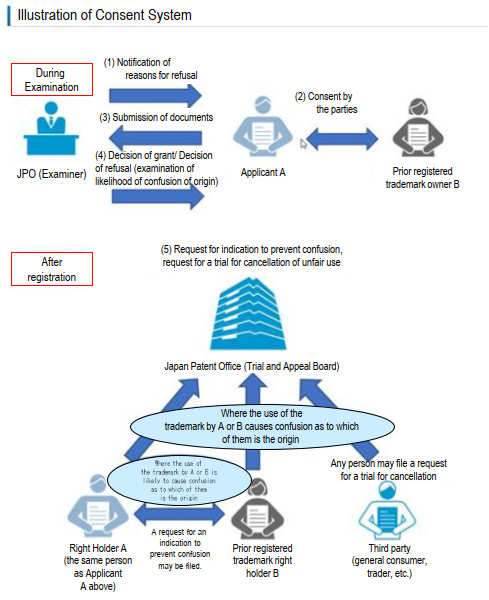
Source: Japan Patent Office<https://www.jpo.go.jp/system/trademark/gaiyo/consent/index.html>
(ii) Relaxation of requirements for registration of trademarks containing the name of another person
Under the Trademark Law prior to the amendment, an application for registration of a trademark that contains the name of another person in the composition thereof could not be registered without the consent of that person. Under the revised Trademark Law, the “name of another person” is now limited to “a name that is widely recognized among consumers in the field of the goods or services in which the trademark is used.” (Article 4(1)(viii) of the Trademark Law). As a result, a trademark that includes the name of another person which does not meet the name recognition requirement does not need the consent of that person, and can be registered as long as it meets the requirements of the Cabinet Order ((a) “Reasonable relationship” and (b) “No dishonest purpose”).
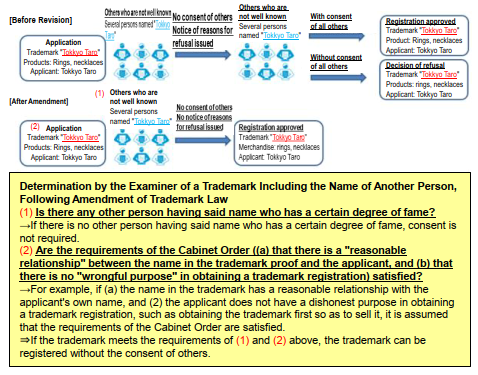
Source: Japan Patent Office<https://www.jpo.go.jp/system/trademark/gaiyo/seidogaiyo/shimei.html>
